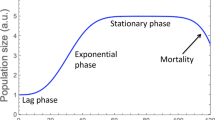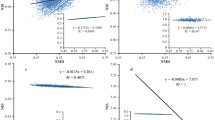Abstract
WHEN a nutrient solution is inoculated with a species of micro-organism, in pure culture, the curve obtained by plotting the population against the time is characteristic and conforms to a general type of growth curve; an initial period of slow increase in numbers being followed by a rapid rise in population which, in turn, is superseded by a decline. An example of such a curve, representing the growth of a species of Actinomyces (measured by the evolution of carbon dioxide) in glucose solution,1 is given in Fig. 1. Winslow2 recognises five phases in bacterial growth curves: (i) phase of adjustment, A—B; (ii) phase of increase, B—C; (iii) phase of crisis, C—D; (iv) phase of decrease, D—E; (v) phase of readjustment, E—F; it is worthy of remark that the diminution in numbers following the period of crisis appears to be due neither to a deficiency in the food supply nor to the formation of toxic substances.
Similar content being viewed by others
References
Corbet, A. S., Rubber Research Institute of Malaya Journal, 3, 16; 1931.
Winslow, C. E. A., "Newer Knowledge of Bacteriology and Immunology" (Univ. Chicago Press), p. 56, 1928.
Ford, H. D., and Ford, E. B., Transactions of the Entomological Society of London, 78, 345; 1930.
Author information
Authors and Affiliations
Rights and permissions
About this article
Cite this article
CORBET, A. The Bacterial Growth Curve and the History of Species. Nature 131, 61–62 (1933). https://doi.org/10.1038/131061a0
Issue Date:
DOI: https://doi.org/10.1038/131061a0
- Springer Nature Limited





